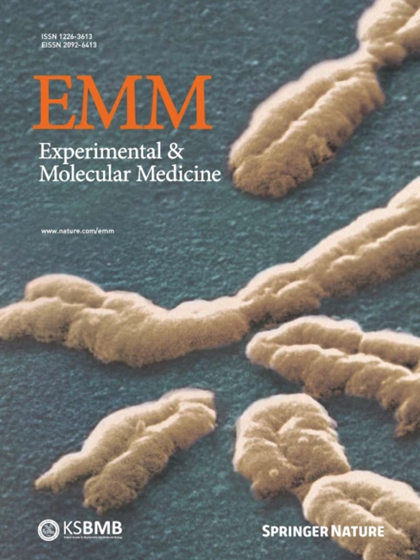类风湿关节炎的严重程度是由滑膜细胞和成熟破骨细胞之间的串扰通过钙和细胞因子反馈回路介导的。
IF 9.5
2区 医学
Q1 BIOCHEMISTRY & MOLECULAR BIOLOGY
引用次数: 0
摘要
成纤维细胞样滑膜细胞(FLSs)和破骨细胞是维持关节稳态的中心细胞。类风湿性关节炎(RA)是一种慢性关节炎症性疾病,可诱导细胞因子激活的FLSs和进行性骨侵蚀。FLSs与其他细胞(如T细胞和B细胞)之间的相互作用已在RA的发展中得到确认。在这里,我们假设成熟破骨细胞从骨中释放的钙可能激活FLSs,而FLSs也受到炎症滑膜中炎症细胞因子的影响。破骨细胞发生在细胞因子刺激的FLS培养基中,从骨盘释放的钙激活FLS迁移。我们首先研究了FLSs和破骨细胞成熟之间的钙和细胞因子反馈回路。此外,通过研究碳酸氢钠共转运体NBCn1在破骨细胞形成中的作用,我们发现NBCn1的抑制减弱了FLSs和破骨细胞之间无限的钙和细胞因子反馈回路。在胶原诱导的关节炎小鼠模型中,抑制NBC减少了RA病理表型和股骨骨吸收面积。这些结果表明,通过抑制钙和细胞因子反馈回路来调节FLSs和破骨细胞之间的串扰可以被认为是对抗RA严重程度和骨稳态失调的开创性策略。本文章由计算机程序翻译,如有差异,请以英文原文为准。

Rheumatoid arthritis severity is mediated by crosstalk between synoviocytes and mature osteoclasts through a calcium and cytokine feedback loop
Fibroblast-like synoviocytes (FLSs) and osteoclasts are central cells in the maintenance of joint homeostasis. Rheumatoid arthritis (RA) is a chronic inflammatory disease of joints that induces cytokine-activated FLSs and progressive bone erosion. Interactions between FLSs and other cells, such as T cells and B cells, have been recognized in the development of RA. Here we hypothesized that calcium released from bone by mature osteoclasts might activate FLSs, which are also affected by inflammatory cytokines in the inflamed synovium. Osteoclastogenesis occurs in the presence of cytokine-stimulated FLS medium, and calcium released from the bone disc activates FLS migration. We first investigated the calcium and cytokine feedback loop between FLSs and osteoclast maturation. Moreover, by addressing the role of the sodium-bicarbonate cotransporter NBCn1 in osteoclastogenesis, we found that the inhibition of NBCn1 attenuated the infinite calcium and cytokine feedback loop between FLSs and osteoclasts. In a collagen-induced arthritis mouse model, the inhibition of NBC reduced the RA pathological phenotype and bone resorption area in the femur. These results suggest that modulation of the crosstalk between FLSs and osteoclasts by inhibiting the calcium and cytokine feedback loop could be considered to develop pioneering strategies to combat RA severity and dysregulated bone homeostasis. Rheumatoid arthritis is a painful condition that damages joints and bones. Despite treatment advances, some patients do not respond well to current therapies. Researchers explored a new approach to address this issue. They focused on calcium and cytokines in RA. The study involved 16 patients and used mouse models to understand how these elements affect joint damage. The researchers found that Ca2+ from bones and inflammatory cytokines increase the activity of fibroblast-like synoviocytes, cells that contribute to joint damage. They discovered that inhibiting a protein called NBCn1, which helps cells move, could reduce this harmful activity. They used a drug called S0859 to block NBCn1 in RA-induced mice, which decreased bone damage and inflammation. The study suggests that targeting NBCn1 could be a new way to treat RA, especially for those who do not respond to existing treatments. This summary was initially drafted using artificial intelligence, then revised and fact-checked by the author.
求助全文
通过发布文献求助,成功后即可免费获取论文全文。
去求助
来源期刊

Experimental and Molecular Medicine
医学-生化与分子生物学
CiteScore
19.50
自引率
0.80%
发文量
166
审稿时长
3 months
期刊介绍:
Experimental & Molecular Medicine (EMM) stands as Korea's pioneering biochemistry journal, established in 1964 and rejuvenated in 1996 as an Open Access, fully peer-reviewed international journal. Dedicated to advancing translational research and showcasing recent breakthroughs in the biomedical realm, EMM invites submissions encompassing genetic, molecular, and cellular studies of human physiology and diseases. Emphasizing the correlation between experimental and translational research and enhanced clinical benefits, the journal actively encourages contributions employing specific molecular tools. Welcoming studies that bridge basic discoveries with clinical relevance, alongside articles demonstrating clear in vivo significance and novelty, Experimental & Molecular Medicine proudly serves as an open-access, online-only repository of cutting-edge medical research.
 求助内容:
求助内容: 应助结果提醒方式:
应助结果提醒方式:


